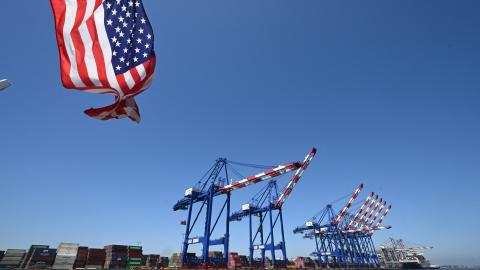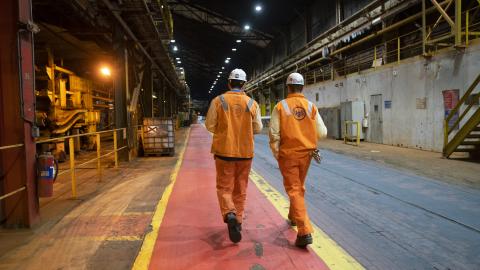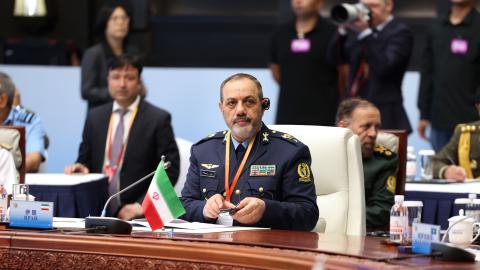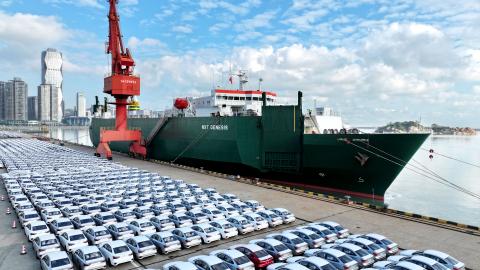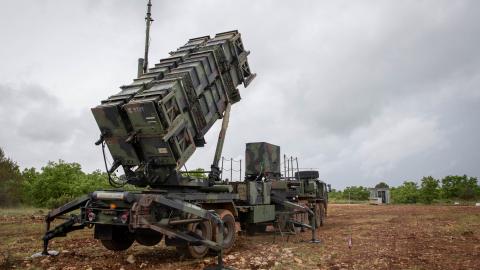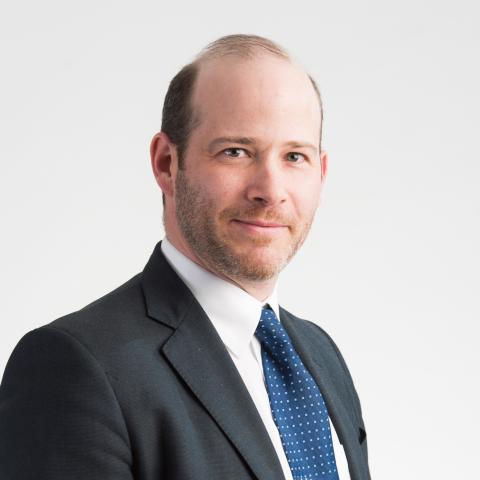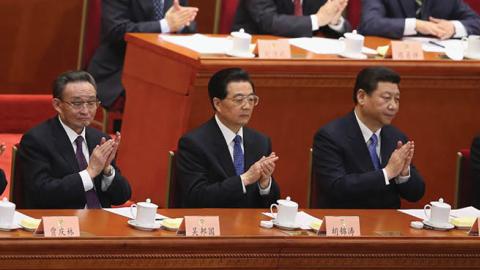The great German historian Leopold von Ranke preached to his peers that they should write about the past “as it actually happened,” and that we should do our best to understand the past “on its own terms.” But since Ranke’s time, radicals and revolutionaries of all kinds have argued that history should be understood on their terms and in accordance with their needs. Today, there is no place in the world where this practice has been more comprehensively implemented than in the People’s Republic of China (PRC). There, as the Pulitzer Prize-winning journalist Ian Johnson writes, “the Communist Party does not just suppress history, it recreates it to serve the present.”1
The Communist Party of China (CCP), since its founding in l921, has viewed itself as an ideological enterprise, led by an intellectual elite, as well as a Party of analysis and study, especially of history. It declares that its conduct is directed by Marxism, a doctrine for comprehending the past and predicting the future, and by Leninism, a science for securing and then retaining political power. In the l920s and 1930s, the CCP was driven out of cities, and it faced near extinction. At that point, Mao Zedong (1893–1976) offered a “correct” analysis and a new program—building the power of the Party in the countryside. Mao led the Party on the famous Long March to a place where it could establish a secure rural base. The Party ultimately went on to win the Chinese Civil War and found the People’s Republic in 1949. However, in the l970s, when the regime had once again become shaky, Deng Xiaoping (1904–97) offered his own analysis and program. He called it “reform and opening up,” and it was designed to connect the previously autarchical PRC to the international economy. Deng’s successful program kept the Party in power for another thirty years.2 But today, by the Party’s own acknowledgment, Deng’s initial arrangement has run its course. It is therefore time to develop a new understanding that will do for the Party in the next 30 years what Deng’s program did in the previous era.3 As Mao and Deng appeared at just the right moment, so too, says the Party, has its current General Secretary, Xi Jinping. Xi’s doctrine, unveiled in October 2017, is known formally as “Xi Jinping Thought on Socialism with Chinese Characteristics for a New Era.”4 In January 2018, Xi Jinping Thought was made part of the Communist Party’s constitution.5
Xi has been in charge since March 2013, and the PRC has become notably different since. Political scientists were once comfortable describing the PRC as “post-totalitarian” or “authoritarian.” Today, the term “neo totalitarian” is more appropriate, as the ruling Party builds the most technologically advanced police state ever known and escalates the repression of millions of its subjects who seek the modern political and religious rights promised under the PRC constitution. The Party also believes that its rule at home can be either strengthened or weakened by trends in the existing world order, trends it seeks to control. Therefore, Xi’s PRC has also launched a many-faceted assault on the post-1991 international order. It has significantly expanded its military power, which it uses to threaten the Chinese-speaking democracy in Taiwan and to press unfounded territorial claims against its neighbors in the Pacific Rim and across the Himalayas. The Party is also engaged in a major propaganda effort to propound a new vision of China as a global hegemon. In all this, the Party has been offering a wholly new ideological justification for the PRC’s existence, one that it says derives from authentically Chinese concepts rooted in China’s deep past, not the modern ideas it has relied on since its creation. These complex and expensive undertakings represent the Party’s considered judgment about how best to cement its power at home. They result from a complex mingling of analysis, ideology, futurology, history, and prophecy. As one might imagine, these are competing influences, and the Party believes that its challenge is to grasp which is the most important at any one time.
A People’s Republic as an Emperor’s Empire
Empires and their colonies were central features of the world order before World War I. Intra-European struggle initiated an era of nationalism and decolonization in Europe which, after World War II, also spread to Africa and Asia. In Europe, the collapse of the Romanovs, the Hapsburgs, and the Ottomans set off a search for a stable equilibrium; today’s Greater Middle East, among other places, is living with the still-unresolved consequences of these imperial breakdowns. Quests to revive former imperial glory bedevil the region’s badly governed and fragile states. Revolutionary Iran and Erdoganist Turkey harbor dreams of recasting the international system in the long term, while they gnaw away at it in the present. Stalin’s recreation of the vast empire of the Tsars came to an end with the disintegration of the Soviet Union in 1991, but his ghost still hovers over a revanchist Kremlin.6 As for “Rising China,” the successor state of the Manchu‑Qing empire, the PRC has managed to avoid the fate of its erstwhile Soviet ally by amassing more wealth and power than any previous Beijing-based regime. But China’s Communist rulers still fear losing their grip, and there are many millions inside the PRC who want out of it. It is not only the Uighur Muslims or the Tibetans who are subject to the Party’s genocidal repression;7 it is also millions in Hong Kong, and an uncountable number of democracy-minded people in China Proper.8 Yet we know that even when Xi’s Party orchestrates the suppression and the imprisonment of academics, lawyers, and human rights advocates, more stand up to take their place.9
These modern developments were foreshadowed in 1912, when the multi-national Eurasian empire of the Manchu-Qing dynasty disintegrated.10 Many dynasties that ruled China had collapsed before, but the Qing collapse was truly without precedent. The Manchus had invaded Ming China and established control over it in 1644, and then, to protect the Chinese-speaking core of their realm, the conquest dynasty added to it an outer ring of other lands that were not Chinese, including Tibet and the Turkic Muslim areass, called “Xinjiang,” the “New Territories,”. in Chinese. As an ethnic minority themselves, the self-conscious Manchus needed the acquiescence and cooperation of the majority, the Han Chinese, to have any chance of retaining their empire. The Aisin Gioro, the Manchu ruling clan, thus adopted Sinic ways, but still feared the betrayal of the Han majority, and thus relied on an adroit application of violence, coercion, payola, and co-optation to keep the Chinese and their penchant for Ming revivalism and “Han chauvinism” under control.11
But, by the early twentieth century, not only had millions of Chinese turned against the reigning dynasty, they had also concluded that dynasties as such had become a threat to the survival of the Chinese as a nation and also as a “race.” In 1905, the dynasty itself had already taken the drastic action of abolishing the centuries-old Chinese civil service examination system, thereby ending the privileged status of Chinese “Confucianism” as the empire’s governing ideology. This opened the way for consideration of a host of new Western political ideologies. Initially, these were “reformist,” as they had been in early twentieth Tsarist Russia. But, in the ensuing decades, a desire for mere “reform” gave way to far more radical solutions.
In February 1912, the Last Emperor abdicated, and in the Manchus’ last decree, declared: “We, the Emperor, hand over the sovereignty to the people. We decide the form of government to be a constitutional republic.” He also ordered the creation of a provisional government that would effect “the union of the five peoples, Manchus, Chinese, Mongolians, Mohammedans, and Tibetans. These peoples jointly constitute the great State of Chung-Hwa Min-Kuo [the Republic of China].”12 Thus, the claimed borders of the new Republic of China became coterminous with what remained of the Manchu-Qing empire on its last day—a bit more than 3,000,000 square miles—of which about half had been the “China” of the pre-Manchu era.
Creating a Chinese Republic on this huge and varied piece of real estate, with its range of peoples and histories, remains an unfinished and deeply contested project. To this day, the basic terms are still in dispute; among the people affected there is no consensus even about what “China” and “republic” mean. In the last century, the intra-republican argument that roiled the Chinese-speaking world centered around the best way to achieve China’s modern rejuvenation. For the Kuomintang and Sun Yat-sen (1866-1925)—himself a Western-educated physician and a Christian—it meant one thing; for Mao Zedong, a xenophobic atheist and doctrinaire Leninist, it meant something else entirely.13 Since 1949, Sun’s republic has been confined to Taiwan, where it has grown into a sophisticated democracy and a nation of 24 million, most of whom think of themselves as Taiwanese, not Chinese. Mao’s so-called “People’s Republic” is the dominant force on the Asian mainland, although it is not the only force.
At its end, the 400 million inhabitants of the Manchu empire were ruled by only two million Manchus. Today, 90 million members of the Communist Party hold power over a land mass inhabited by 1.4 billion people. The majority of these inhabitants are non-communists and many millions of them do not think of themselves as Chinese at all. Indeed, even after seven decades, the Party’s foundational claim to the Manchu’s former empire is a long way from acceptance. The Party, by its own acknowledgment, must struggle every day against ethno-religious “splittism” and “reactionaries” and “anti-patriotic” sentiments of all kinds just to keep the PRC intact. 14 This is precisely why the Party incessantly repeats, badgers, and threatens its subject peoples and the world at-large to acquiesce to its idea of “One China.” 15
“In places like Xinjiang and Tibet,” as the eminent political scientist Bruce Jacobs, reminded us, “the Chinese are running a colonial regime, a regime that’s run by outsiders for the benefit of the outsiders.”16 But, this was not always the case. In 1912, the newly proclaimed Republic of China was assaulted on all sides by domestic disorder and foreign pressure. As a result of the republic’s inability to enforce its writ, regional “warlordism” overtook China, and places like East Turkestan/Xinjiang effectively became independent. In the 1940s, East Turkestan's political life was conducted under the aegis of the East Turkestan Republic. In reality, the republic was just a loose coalition of local power holders that, despite a period of Soviet-backing, never secured international recognition. All this changed when Communists seized power over China. Beijing’s Tibetan colony, not subdued until 1959 after ten years of guerrilla warfare, remains loyal to the exiled Dalai Lama. Today, it is under de facto martial law and military occupation, while the PRC uses its control of Tibet to press territorial claims against India and other Himalayan polities. Since 1955, East Turkestan has been called—formally—the Xinjiang Uyghur Autonomous Region. Today, with upwards of one million Uighurs in concentration camps for “political re-education” and forced labor, Xinjiang is the most heavily garrisoned part of the PRC and the main base of operations for PRC’s larger strategic designs on the Eurasian landmass.17
“To destroy a people,” the Manchu-era reformer Gong Zichen (1792-1842) observed, “you must first destroy their history.” This statement encapsulates the Party’s many-faceted plan to “Sinicize” the Uyghurs and others.18 But it was not the reason why Xi cited Gong in a 2013 speech (not published until 2019) shortly after he became General Secretary. Instead, Xi feared the disappearance of a particular kind of people: the Chinese Communists. The Soviet Union, he said, came apart because its political leadership repudiated their revolutionary history and doctrines; this wrought “chaos” and dysfunction in the Soviet machinery, and they lost their nerve.19 Xi said “hostile forces at home and abroad” promoting “historical nihilism” were likewise a mortal threat to PRC, and he enjoined his fellow Party members that their struggle in the “ideological domain” is a “fierce” one.20 That is why Xi has orchestrated a sweeping crackdown against “anti-China” elements throughout the PRC. Yet even as thousands are detained or “disappeared,” more appear to take their place.21
For example, Hong Kong, once the most internationally connected part of the PRC, is now under martial law. And yet, hundreds of thousands of pro-democracy Hong Kongers continue to parade in open defiance of Beijing. That is one reason why the PRC is investing billions in panoptical surveillance and population control technologies.22 Beijing touts its new form of “digital tyranny” and bid for total information dominance as a model for other regimes which reject modern Rule of Law concepts. But, for all its self-congratulatory strutting about leading the world, the Party’s grip on its subject peoples is maintained at substantial cost. Clearly, though the Party confidently pretends otherwise, it surely knows that something is not working, and that something, is the very modern political project that began with the acceptance of a Western-style republic. The PRC has all the forms of a modern republic, including a rights-guaranteeing constitution, but its actual practice has been quite different. This contradiction—to use one of the Party’s venerable terms—is becoming harder to sustain, and the Party, we can imagine, has reckoned it would have an easier time if it shed the pretense altogether. There may have been a time when some were fooled by it, but no one is any longer, least of all those who are subjected to PRC rule
How Chinese is the People’s Republic of China?
All this is a reminder of an essential political fact: “China” and the “PRC” are not the same thing, even though most of us use the terms interchangeably. “China” is a place and a civilization; over the centuries, its size and shape have shifted, just as its character and governance have. But the People’s Republic of China is not a place, it is a thing—a ruling arrangement set up in 1949 by Chinese Communists as a tool for maintaining their monopoly on power and retaining their empire. The PRC asserts it is the last and best state for all of China. In this, the Party’s purpose has been constant, but since 1949, its methods have changed. Its confidence in its capacity to cope is born of its faith that, though “objective circumstance” may change, Party doctrine is up to the challenge of ensuring, first, the Party’s survival and, second, the preservation of its power.
Survival requires discipline and deference to inherited doctrine, but the Party also believes that it should not allow itself to be paralyzed by it. In Leninist lingo, this is called “tactical flexibility,” and it necessitates that the past continues to change to serve the needs of the political leadership. At one time, the Party portrayed the Manchu-Qing dynasty as colluding with the European powers and Japan against the interests of the Chinese people; the Manchus were thus a prime architect of the “Century of Humiliation.” The phrase remains prominent in PRC propaganda, but today, foreign villains dominate the story. Similarly, the Party once inveighed against Manchu imperialism, but now, it honors the Qing dynasty for creating “One China.”
The Party has been similarly flexible in managing the PRC itself. In its first version, which we call PRC I, it loyally followed Stalin’s foreign policies and implemented a Stalinist approach to economic growth. Although, PRC I also had an international agenda of its own. It is not much remembered now, but, as British historian Julia Lovell has documented, Mao Zedong and his ideology were an international sensation. Maoism drove the many countries it gripped, including China, to ruin even though today this is almost entirely forgotten, to the great benefit of China's communists. PRC I had made a play for worldwide stature that its actual power was unable to support and it had humiliated itself in the process. It thought to unite the former colonies of Europe on the basis of ideology and race, and to arm them with Mao’s strategy of “people’s war.” The Party’s new leader, Deng Xiaoping, became famous for advocating that China’s rulers should play the long game—“hide your strength, bide your time,” was his advice to fellow communists. In saying this, Deng was not being humble, just realistic.23
Deng’s PRC II launched what the world came to know as Rising China.Its economy was patterned on the high-growth, export-led economies of its Asian neighbors—Japan, South Korea, Taiwan, Singapore, and Hong Kong—though it remained tightly controlled and guided by the political leadership. The Party, which had once condemned capitalism as a forceful imposition of Western imperialism, began to celebrate capitalism’s homegrown roots. Indeed, to establish a new governing narrative, the CCP readily embraced a new reading of the “progressive” nature of China’s modern encounter with the West. Unlike the emphatically “Eurasianist” character of previous Beijing-based regimes, China’s coastal cities acquired an “oceans” outlook which emphasized deepened cooperation with the democracies of the Maritime World, not enmity or rivalry.
In a fundamental sense, PRC II was only taking up where the Chinese reformers of the late Manchu era—the “Self-Strengtheners”—had been forced to leave off because of the republican revolution.24 Yet, ironically, in attempting to save the dynasty by its own version of “reform and opening up,” late Qing statesmen were also inadvertently accelerating the dynasty’s demise by unleashing modernizing forces the dynasty could not contain. Theoreticians trained in Marxist dialectics have little difficulty in understanding this; Marx believed that every era produces within itself the seeds of its own destruction and, in 1937, Mao himself predicted that major contradictions would arise even in a post-revolutionary society like the one China was becoming.25
Accordingly, the Party came to conclude that Deng’s formula was no longer tenable; among other things, the openness and allure of such “universal values” as liberty, Rule of Law, and human rights could never co-exist with the Party’s core Leninist-Stalinist-Maoist operational code. The Party thus began to look to the day when the PRC’s arrangements at home and its presence in the world would be sufficiently cemented to contemplate a gradual disengagement from the existing international order. Thus, just as PRC I after 30 years had given way to PRC II as a matter of necessity, PRC II began to give way to a PRC III as a matter of choice.
The Communist Party of China now rules over an empire that is richer by far than any previous Asian polity, but wealth, alone, is not enough. That is the point of the massive “Belt and Road” Project, which Xi unveiled in 2013 in a speech in Kazakhstan and which became a part of the Party’s constitution in 2017.26 In putting forward this scheme, Xi is aiming not just to improve PRC’s strategic positioning around the world by cultivating and capturing economic and technological dependencies beholden to the PRC, but to build a more supportive world order, one that is more favorable to the Party’s continued control over its empire. In this, Xi Jinping may well aspire to the world-wide adulation of the sort once enjoyed by Mao Zedong, but neither he nor his Party can rely entirely on the Marxist-Leninist doctrines that the world has passed by. If China’s Communist Party is to become a “vanguard party” once again, PRC III cannot be an end in itself, for it would then be merely reactive, defining itself by what it is not. The Party still thinks of itself as an intellectual elite engaged with big ideas. Therefore, the Party’s creation, the PRC, cannot be just anything; it must mean something, and it must be a world leader.
Is the PRC Strong Enough to Challenge the World?
The PRC III that is being built today joins the wealth and power of PRC II with the ideological and strategic audacity of PRC I. In fact, Xi Jinping’s project suggests that the very notion of “modern” is itself now up for grabs, for Xi is segueing to “traditional” thinking as a basis for legitimating CCP behavior both domestically and internationally.
Since PRC’s founding, the ruling Party has been unceasing in its efforts to eliminate the vestiges of non-Communist thought. Western-derived principles and concepts could be denounced because of their foreign origins; they were an “un-Chinese” activity. Accordingly, belief in secular ideas about constitutionalism and democracy were inherently unpatriotic and treasonous. Christianity was even worse, and the Communists were as intense in their anti-Christian passions as were the Boxers. Of course, the Party itself was a stepchild of Western politics and was also militantly atheist. But because Jesus’ kingdom was not of this world, a believing Christian could hardly follow Mao’s famous dictum—“put politics in command.”27
Ultimately, the centuries of China’s homegrown political and religious traditions could not be so easily dismissed. They were, after all, Chinese in origin and not the forced imposition of Western and Japanese imperialists. The campaign against traditional Chinese political thought—Confucianism, in shorthand—was that much more relentless. It reached a crescendo during the era of the Great Proletarian Cultural Revolution—1965-1976—when the anti-Confucius campaign was in full swing. Confucius himself was portrayed as an apologist for slavery and tyranny and his teachings were said to be used by evil emperors and ministers to control and exploit the people. As far as the Party was concerned, Confucian ideology was a dangerously subversive weapon, now employed by counterrevolutionaries at home and by the PRC’s enemies abroad.28
Thus, it was startling when, shortly after taking power in 2013, Xi Jinping set out to rehabilitate Confucius himself, and traditional Chinese culture more generally. He visited the Great Sage’s birthplace in Shandong Province, encouraged Chinese to read The Analects, and described the Party as a defender of China’s high traditions and virtues. One result of Xi’s visit was that Qufu, Confucius’ hometown, almost overnight, became a Mecca for millions of tourists.29 On September 24, 2014, Xi also addressed an international gathering convened to celebrate the 2,565th anniversary of Confucius’ birth.30 As is his rhetorical way, Xi went on at ponderous length to extol traditional Chinese civilization and its contributions to world civilization.
Rising China became rich and powerful because it was able to operate in a liberal world order which enabled the PRC’s renovation when it had no other options. But the PRC is now offering its own version of a rightly-ordered world. Here, the master concept is Tianxia—“All Under Heaven”—the notion that the world is properly governed by a benign emperor who establishes harmony and order for the good of all. The most powerful visions of world order that arose after World War II, whether Wilsonian or Leninist, were designed to supersede older notions of empire which had produced the disaster of World War I. Both the Wilsonian and Leninist visions were, in this sense, “universal,” and thus in principle accessible to all sovereign states. But, the PRC’s reversion to Tianxia notions is provincial and is expressed in a language carefully cultivated and policed by the Party which the political scientist William Callahan has called “Sino-speak”:
In the 1980s and 1990s, the discourse of the ‘Pacific century’ and then the ‘Asian century’ talked of the trans-boundary and trans-oceanic economic and social networks that knit together the Pacific rim.… But instead of celebrating cross-border flows, Sino-speak looks to China’s eternal civilization to determine social, cultural and territorial borders…This is not simply a scholarly debate because Sino-speak is heavily promoted by government officials, state media, and official intellectuals in China. 31
This effort by Xi’s Communist Party to recast international order and enmesh other nations in a new China-dominated one is analogous to Mao Zedong’s “protracted war” to do the same in his time. Mao’s vision was one of “proletarian internationalism,” an internationalism open to all peoples and all place but one where the PRC would nonetheless enjoy pride of place. Xi would also like PRC to be at top of the global pecking order, and one has to think that Xi has concluded that he, unlike Mao, has at his command wealth and power equal to the task.
How Modern is Modern China?
It is important that we place the Party’s embrace of these “authentically Chinese” sentiments in a proper historical context. The “modern” in politics came to China decisively—and seemingly irrevocably—when “dynasty” and “empire” gave way to “republic” in 1912. The struggle that consumed the Chinese-speaking world after this transition was over two competing forms of republicanism. Which kind of republicanism would be the best scheme for China’s historical rejuvenation? While the Communist Party’s version of republican structure won out on the mainland, the Party knows its Marxist-Leninist ideology can no longer be relied on to induce loyalty at home or build a more supportive world order. As such, the Communism that Xi Jinping embraces has moved beyond this particular argument. If we take seriously his willingness to subordinate modern and universal concepts and terms to wholly Chinese ones, how far along this road is the Party prepared to travel? Will the PRC embrace foundational doctrines not because they are universal but because they are exclusively Chinese, which is to say, ethno-nationalist or race-based?
We have seen this migration in other sophisticated societies which had to cope with the strains of rapid transformation, and they turned on modernity altogether. Several totalitarian projects of the last century—the Nazi’s Third Reich in particular—offer cautionary lessons of where this could lead. Is there any more evidence needed out of places like Xinjiang for the world to conclude that a part of the PRC is not already there? But more apt may be Imperial Japan’s turn away, in the 1930s, from modern and universal political thought to an outlook that was said to be uniquely, purely, Japanese. Its supporters said that outsiders found it unfathomable precisely because they were not Japanese and, as such, would never be able to grasp it. In particular, they would never understand why Japan was eager to wage a war—“to bring the eight corners of the world under one roof”—so that all people could bask in the munificence of Japan’s emperor. To Imperial Japan’s wartime leader, Tojo Hideiki, and to his fanatical followers, this may have made perfect sense, but to the rest of the world, it was just plain crazy, not only doctrinally but also strategically. Yet to Japanese fascists, none of this mattered and, over time, their behavior became increasing surly, aggressive, and militaristic.
The rise of Imperial Japan once dominated modern Asia’s story. In the 75 years between the Meiji Restoration and the end of World War II, Japan went from an exotic and little-known island country of uncertain prospects to the owner of an enormous empire. Japan struck out in many directions simultaneously—on the Eurasian continent and across the seas—acting as if the traditional constraints of grand strategy did not apply to it. For a while, it went well. Japan’s empire reached from the Western Aleutians at the edge of North America to the Amur River in northeast Asia, from the heart of China deep into the central Pacific, from mainland Indochina and throughout the adjacent archipelagos all the way to the edge of Australia .
Yet fewer than four years after the surprise attack on Pearl Harbor, all this—the work of two generations—was gone. The imperial system in whose name this struggle had been undertaken barely survived even symbolically, and the physical ruin of the country, and much of the rest of Asia, China included, was nearly total. We in the West would call this a cautionary tale, not least about the tragedy that comes when great civilizations are taken over by self-serving despots and anti-modern totalitarians. For the United States, one of the enduring lessons of the Great Pacific War was that any regime that claimed peaceful intentions needed also to be respecting of the rights enumerated in the United Nations Universal Declaration of Human Rights. The United States has sought to embed that lesson in the post-1945 liberal international order of sovereign and co-equal states that it promoted and defends still. Yet, we do not know what lessons the leaders of the Chinese Communist Party have drawn from their own study of this tragic history. How will Xi’s Party choose as it pursues its longing for world dominance?
Will the PRC Hold Out Against the World?
Politics is always an argument about the future, a future that has not yet happened. Even as students of China, whether there or elsewhere, argue about the past, there is an ongoing and lively argument about where that contested past may be leading us. In 2020 and beyond, the Party has many looming contradictions to resolve, but three stand out. First is the struggle inside the Party over how to pursue its dreams of “national rejuvenation.” In this, it is important to remember Xi’s ascent in 2013 was itself close-run, and a coalition led by his now life-imprisoned rival, Bo Xilai, came near to prevailing. The “anti-corruption” campaigns in the years since—old-fashioned Party purges in reality—betray the deep sense of insecurity at the very top of the political pinnacle.33
The Party will also need to resolve its inner debate over whether its stated goal of transforming the PRC into a “major power with pioneering global influence” can be achieved from within the existing international system, still dominated by the advanced democracies, or whether PRC needs to break the international order as such and remake it. This is a matter of “grand strategy” of the highest importance, for the obstacles to the Party’s recasting of world order are powerful. We are already seeing a gradual coalescence of the current order’s defenders—countries of economic and military heft like Japan, Australia, India, Taiwan, the United Kingdom, France, Germany and, of course, the United States itself. The Party, in the Deng era, depended on the cooperation of these advanced democracies to save itself. But now, as the Party brutalizes the people inside the PRC and every day threatens the general peace in Asia, will the democracies continue to empower the PRC? What, in fact, are the democracies prepared to do to protect the very order that has been so integral to their own unprecedented well-being?
Chinese resentments against Xi are growing, and given the Party’s penchant for tactical flexibility, it is conceivable that sustained international pressure will compel it to revert to the more measured and cooperative approach of PRC II. Then again, Xi has ordered his Party to prepare for a “New Long March,” and the adherents of his line appear to have concluded the post-1991 world order is already gone.34 On that analysis, the Party may continue to seek to collude with or enlist other regimes, equally revisionist in their ambitions, in the PRC’s cause. Indeed, the Party’s invocation of the “authentic” and anti-universal is not an isolated phenomenon. It mimes developments in other deeply aggrieved authoritarian ruling regimes, including Iran and Erdoganist Turkey, and also Putin’s Russia, that have sought to cement their power at home by contesting the international order. Around the world, kleptocracies and authoritarians of all kinds that have been left out or opted out of the liberal order have given the PRC a relatively free hand to pursue its geopolitical aggrandizement. Acquiring these dependencies s crucial for Xi’s geo-strategy, but they are and will become increasingly expensive for a less-than-robust Chinese economy to keep afloat.
The second contradiction is the foundational struggle between “China” and the “People’s Republic of China.” Not long ago, it was widely speculated that China’s re-rise would bring about a larger convergence of the Sinophone World, including not just China Proper, but also Hong Kong, Taiwan, Singapore, and a farther diaspora of Chinese speakers. But each of these communities of “overseas China” has its own history and character, and Xi’s PRC with its imperialism, chauvinism, brutality, predation, and militarism is losing what luster it might have had. There is a reason why the self-determining polities of offshore “China” are identifying more and more as not-Chinese. In Hong Kong, the Party has resolved to crush this dynamic, and it is hard to see how this compulsion will not become more destructive, especially self-destructive. Yet were the Party to concede this argument about the Sinophone World’s future, Xi Jinping’s dream of “national rejuvenation” would become a nightmare for Communists, but a happy awakening for everyone else. The “intra-civilizational” arguments to come inside “Greater China” will be defining of the next epoch in Asia and the world beyond.
In this, there is yet a third contradiction, one created by the Party’s appropriation of China’s heritage, including of Confucianism. Confucianism is a richly varied tradition, one that has been made to serve the interests of political rulers, but which is also humane and not a manual for “neo-totalitarianism with Chinese characteristics.” As such, many who helped launch China on its republican path argued Confucianism is a natural supporter of not just modern social contracts, but core human rights. That is one reason why many Americans once saw in the emergence of modern China an ally in the building of a better order in Asia. It is also why the Communist Party has been at war with China and its past; indeed, it once thought the Party had destroyed Confucianism, and, having done so, it now thinks it can recreate Confucianism to serve its present-day ambitions.
One senses this is an embrace born of desperation, of a need to re-write the history of the PRC yet again, for the Party to explain itself once more to the many peoples it rules. In this, the Party is not likely to succeed, and it will thus face a stark choice between two “China Models.” One is the way of Xi Jinping—more repression and ethno-nationalism at home and an unceasing manufacturing of international tensions. The other way, of course, is the way of those Chinese who see the universal in their past, and who compete for self-betterment and advantage and the respect of other nations in the modern world, not against the world. This would require a transition from the PRC III to a proto-democratic PRC IV. To be sure, Xi’s Party is driving China toward an altogether different future. But China is far bigger, still more connected internationally and more modern in its aspirations than its backward-gazing Communist leaders. Nearly overnight, the quasi-fascist system on the Chinese-speaking island of Taiwan rapidly gave way to a constitutional democratic one. All this is to say that this particular argument about the future—modern China’s future—is still an open one, and that there are untold millions of Chinese people who have not given up.
